10 Relationship Email Examples to Keep Your Customers Happy
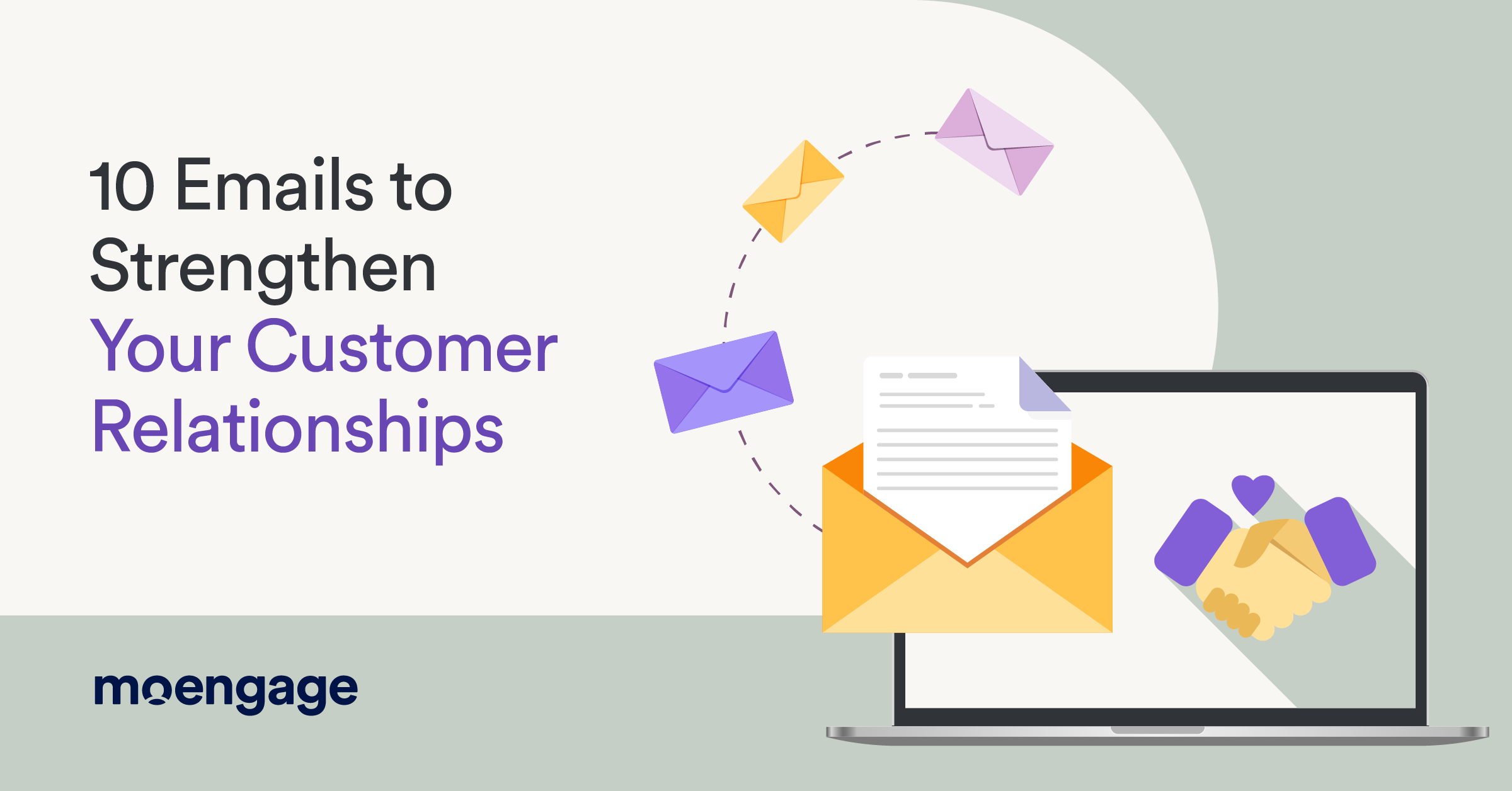
Reading Time: 10 minutes
Here’s the truth about customer relationship email marketing: If you want to retain customers, generic one-off sales emails don’t cut it anymore.
There are mountains of data to support the claim that email marketing is more effective than social media at building and retaining customer relationships. In a hyper-connected society where personalization and authenticity matter, people expect brands to understand them, engage with them, and earn their trust. So if you haven’t prioritized building your email list, don’t delay any further!
In this post, we’ll break down what relationship emails are, why they matter, and share real-world examples across industries to inspire your strategy.
In Email Marketing, What Is A Relationship Email?
A relationship email is a personalized message designed to build a lasting connection with the customer instead of driving an immediate sale. It nurtures trust, engagement, and loyalty by offering relevant content, updates, or support that keeps customers connected to your brand over time.
Unlike sales emails, customer relationship management emails prioritize customer engagement. Apart from other email marketing benefits, they offer value through helpful content, personalized recommendations, and exclusive updates. They keep your audience connected to your brand, making them feel valued and understood.
So, what are relationship email best practices? Let’s find out with examples from brands that got engagement email marketing just right.
10 Relationship Email Examples by Industry
Choosing the right approach to relationship emails can strengthen customer loyalty and increase engagement across industries. These examples from Ecommerce, media, food service, or finance highlight best practices to keep in mind for creating effective emails that keep customers connected to your brand. With the help of email marketing software, you can automate and personalize these messages to drive even better results.
Ecommerce and Retail Customer Relationship Email Examples
Retail brands rely on strong customer relationships to drive repeat purchases and loyalty. And because Ecommerce brands don’t have a physical storefront, they must use digital touchpoints—especially email—to engage customers and build trust. This is where retail and Ecommerce email personalization comes in for engaging customers.
Customer relationship emails create a seamless shopping experience by offering value at key moments, from personalized recommendations to post-purchase follow-ups. These emails keep brands top-of-mind and make customers feel appreciated, increasing retention and repeat sales. That’s the power of B2C email marketing!
1. Order Confirmation with Tracking Number Email
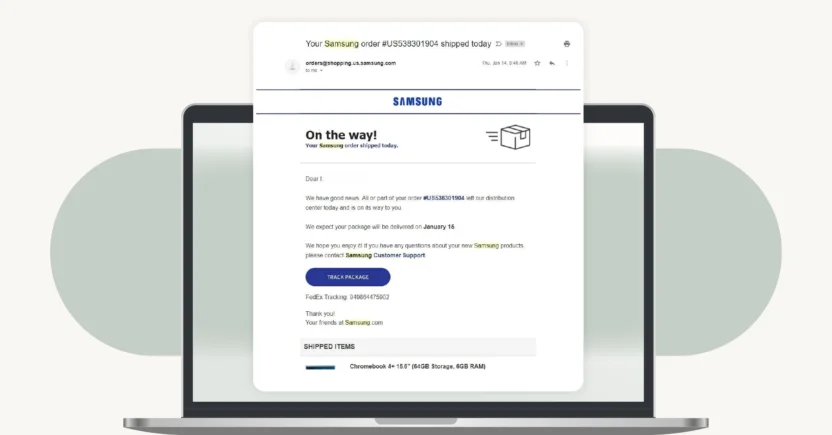
Example Subject Line To Use Here: “[Name], your Samsung order is on the way!”
Why It Works: Customers are usually excited about their order and appreciate having real-time access to track delivery.
One area of business, particularly in Ecommerce, that gets overlooked too often is the shipping and inventory management side of the whole operation. It’s easy to assume that as long as customers love your product, they’ll come back to you again and again.
Do yourself a favor and shake off that complacent assumption. The moment they place an order, send them an automated order confirmation email letting them know you received their order request.
Send them another email, like the above example from Samsung, notifying them that the order has been shipped and is on its way. Including the order number in the subject line and the FedEx tracking number in the email itself is a really smart move for a couple of reasons:
- If the customer has a question about the order and replies to Samsung, their customer service team can quickly copy-paste that internal order number into their system to check on its status. No more manually entering order numbers into the inventory management system whenever there’s a reply!
- Including the full tracking number with a button that takes the customer directly to the carrier’s website (in this case, FedEx) makes life much easier for them when they want to check where the package is during transit and the ETA.
Making one-stop-shop tracking as easy as possible is a small gesture that will make your customers just a tiny bit happier and a little less stressed while they wait for their package to arrive.
2. Timely (and Honest) Order Update Email
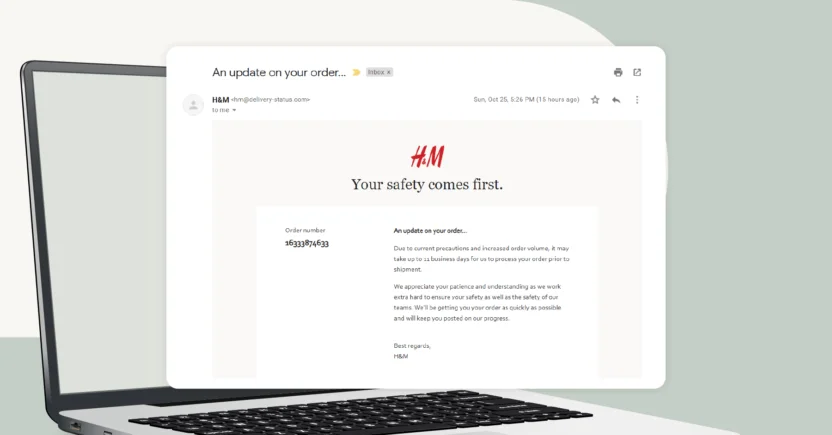
Example Subject Line To Use Here: “An update on your H&M order”
Why It Works: Customers appreciate transparency and honesty.
Don’t keep your customers in the dark. Be honest with them and let them know when your Ecommerce store is struggling with backorders.
It’s not pleasant hearing from X Company that the item you ordered from them three days ago won’t be delivered for another week. But that’s better than hearing nothing at all. This email from H&M, sent in late October during the prolonged run-up to Black Friday 2020, does an excellent job of setting expectations accordingly.
It makes it clear that the primary reason for the delayed shipment is the customer’s safety. Many fashion retailers staged protocols to allow for the downtime of returned items in their warehouse. This helped them minimize the potential for contact spread of the virus (not nearly as likely as an airborne spread) before sending inventory out to different customers.
You’ll notice that “increased order volume” is still mentioned as a reason for the delay, and truthfully, this could be more of a cause than safety. But that’s why this is a good example of email marketing automation through an order update email. Blaming a virus and upholding your company’s high safety standards is a much better excuse than admitting you didn’t have the capacity to handle so many orders. Your customers will probably be more forgiving of the former than the latter. And they’ll appreciate the heads-up that their order is running late than if you don’t tell them anything at all.
3. Sales and Limited Time Offer (LTO) Promo Emails
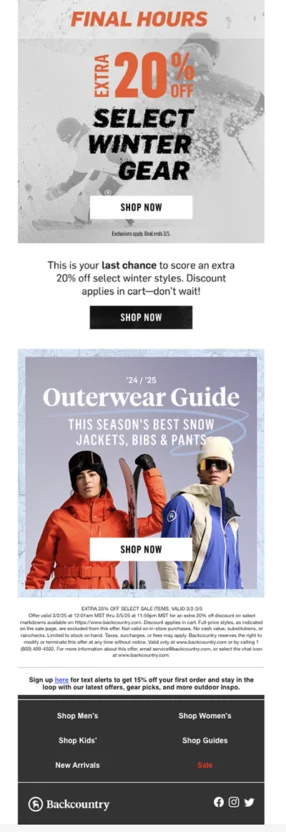
Example Subject Line To Use Here: “Last call! Extra 20% off already-on-sale styles”
Why It Works: Nothing creates a sense of urgency more than the possibility of missing out on a huge savings opportunity.
What upsets a buyer more than not getting a good deal? Missing out on a limited-time deal. And when you allow a customer to cash in on both, you may have the winning combination in your hands!
This email from Backcountry not only informs customers that they have the chance to save an extra 20% on already-discounted items (hooray for sale-on-sale!) but that it’s their last chance to cash in during the sale’s final hours. Letting your customers know that the clock is ticking is a great strategy to spring them into immediate action.
But it’s not just about the sale. As part of an email marketing strategy that focuses on building relationships with customers, the above email example also includes a prominent link to the brand’s custom Outerwear Guide, which highlights the latest outerwear trends. So the email doesn’t just give them a great offer. It also helps inform their shopping choices by inspiring them with what’s in style.
Media and Entertainment Customer Relationship Email Examples
Media and entertainment brands thrive on engagement and connecting audiences to their content. With so many online content options available, maintaining viewer interest requires more than just great programming—consistent and meaningful communication.
Customer relationship emails help by offering personalized recommendations, exclusive previews, and important updates that keep subscribers engaged. By delivering relevant content directly to their inbox, brands can strengthen loyalty, reduce churn, and ensure their audience keeps coming back for more.
4. Exclusive ‘What’s New’ Email
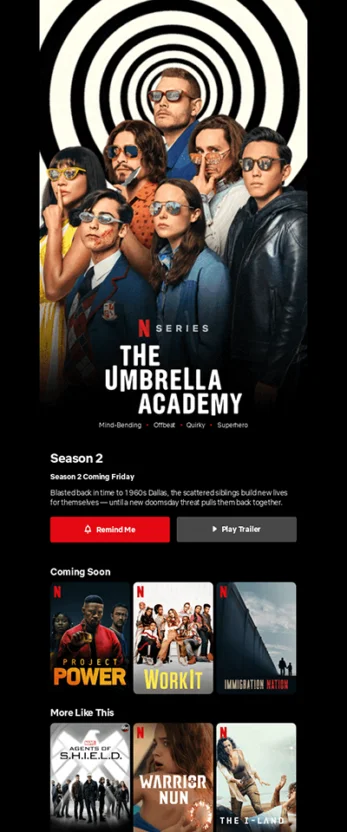
Example Subject Line To Use Here: “[Name], here’s what’s coming soon to Netflix!”
Why It Works: Builds anticipation and strengthens brand loyalty by making subscribers feel excited about what’s coming.
Exclusive sneak-peek emails work exceptionally well for streaming services like Netflix, which regularly updates its content library. By providing a preview of upcoming releases, Netflix ensures subscribers stay excited about their membership.
To maximize engagement, these emails must be crafted with high-quality visuals, short teaser descriptions, and an easy way to add upcoming content to a watchlist or calendar. Dynamic personalization—such as highlighting upcoming releases based on a subscriber’s viewing history—can further enhance the relevance of the email and encourage immediate action.
5. Subscription Updates Email
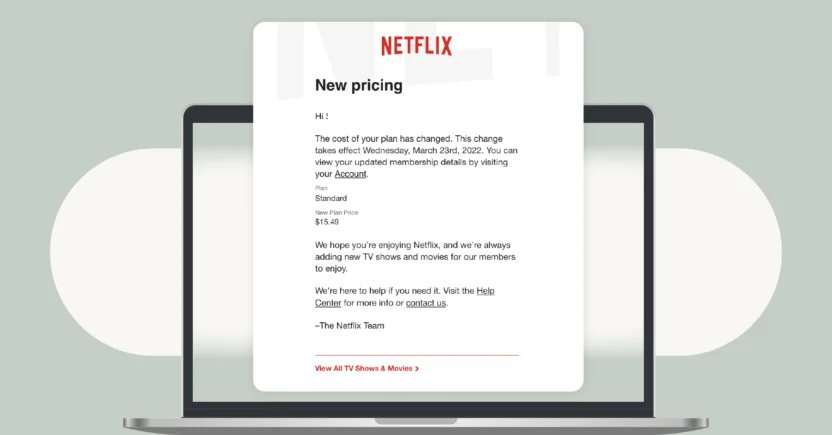
Example Subject Line To Use Here: “Updates to Your Netflix Subscription – What You Need to Know”
Why It Works: Transparency is key in maintaining customer trust, especially when making changes that affect pricing.
Sometimes you need to deliver not-so-good news. And while nobody likes to hear that their subscription cost is rising, it’s much better to be upfront and proactively inform customers of price adjustments. You don’t want them to be caught off guard when they see an unexpected charge on their bill, as it could lead to frustration and membership cancellations.
A friendly and straightforward message that reassures customers about the service’s benefits—such as continued investments in high-quality content—can help maintain positive web and mobile customer engagement with your product.
QSR and Food Service Customer Relationship Email Examples
In the competitive world of treats and quick bites, getting customers to come back for more isn’t just about great food—it’s about making them feel appreciated. A well-timed email with a tempting offer or a sneak peek at a new menu item can keep your brand top of mind. When done right, these emails feel less like marketing and more like a friendly nudge to treat themselves (because who doesn’t love a free offer or a surprise discount?).
6. New Menu Launch Email
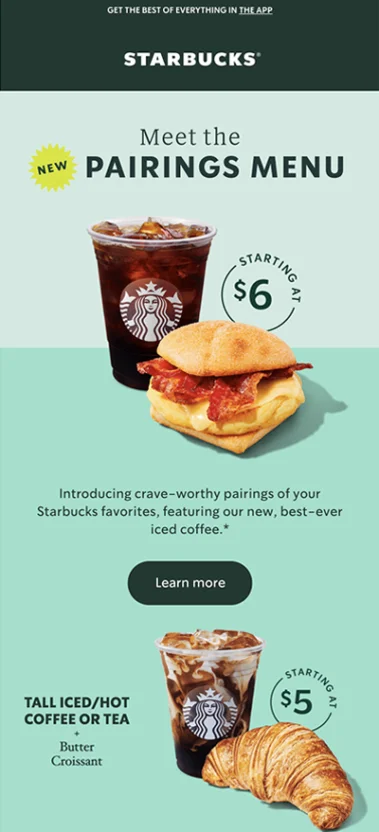
Example Subject Line To Use Here: “Say hello to the new pairings menu!”
Why It Works: Creates excitement and drives in-store or online visits.
While many people frequent restaurants and eateries offering their favorite tried-and-true menu items, a true fan also gets excited when new menu items become available. Especially when it’s attached to a fabulous deal!
Emails that announce new menu offerings help customers feel like they’re in the inner circle. This helps boost brand connection and loyalty. In this example, Starbucks seals the deal with a beautiful email design, and prominent and delicious-looking photos.
7. Welcome Email with Offer
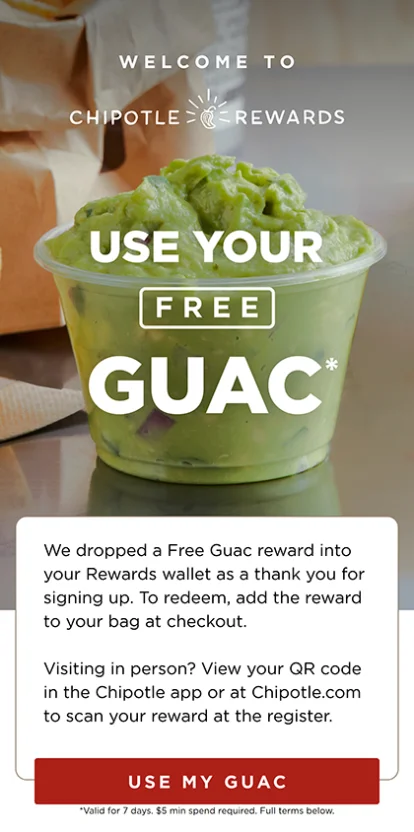
Example Subject Line To Use Here: “Welcome to Chipotle Rewards – Guac’s on Us!”
Why It Works: Customers love an offer and drive in-store visits or online orders that will likely lead to a larger purchase.
A well-crafted welcome email instantly makes a great first impression by rewarding new customers for signing up. In this case, it’s for Chipotle’s reward program. The free guacamole offer immediately incentivizes first-time customers to visit the restaurant, increasing the likelihood of repeat visits.
This offer also creates a sense of exclusivity, making customers feel like they are getting a special perk just for joining. Plus, when customers redeem their offer, they’ll most likely be buying other higher-ticket items to accompany that delicious guacamole.
To maximize the impact of a welcome email, make sure it includes a clear and enticing call to action, as Chipotle has done with a prominent “Use my guac” button. And, of course, don’t forget to add a flawless photo of the food items to really whet their appetite!
The email should also reinforce the value of signing up. One way to do that is by highlighting additional loyalty program benefits, such as earning points or receiving personalized discounts. Keeping the messaging friendly, engaging, and on-brand will further enhance customer excitement and maximize long-term email engagement.
8. Win-Back Email
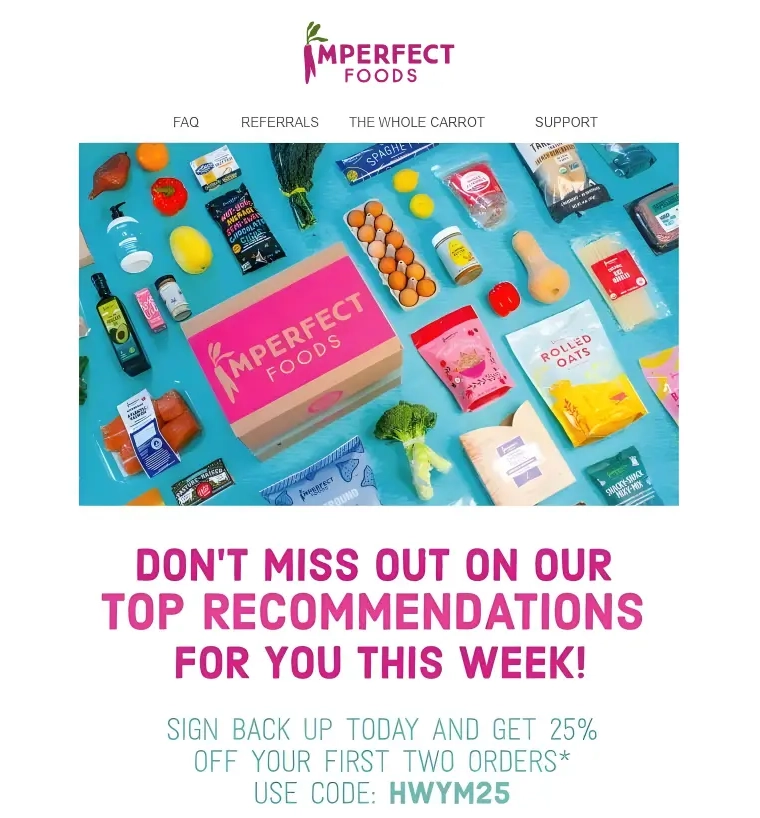
Example Subject Line To Use Here: “A sneak peek at the delish produce you’re missing”
Why It Works: Taps into customers’ sense of FOMO and nudges them to reconsider your products with a special discount opportunity.
Inevitably, some of your customers will stop buying your product or simply stop engaging with your brand. After some time passes, it’s worth reaching out to see if they’ve had a change of heart.
Maybe they miss your product. Maybe they actually liked it, but it seemed too expensive for them when they were checking it out.
Sending them an email that tries to win them back is worth a shot. The upshot is, they might come back. Structuring a win-back email starts with an eye-catching subject line like this one from food box company Imperfect Foods.
“Sneak peak” implies exclusivity, and the eye emojis make it a little silly and light-hearted. Most importantly, a generous 25% discount code makes for a compelling reason to give them another chance.
If you don’t try to reach one-and-done customers at least once via email, you’re potentially passing up a small yet important number of long-term relationships that will end up happening with competitors. Sending a win-back email as a Hail Mary, even if the likelihood isn’t great, is worth a try.
But if you maintain a steady flow of well-timed and clever emails along the entire customer journey, who knows? You might not have to send many win-back emails at all.
Financial and Banking Customer Relationship Email Examples
Trust is everything in banking and finance, and the right emails can reinforce that trust while keeping customers informed and engaged. Whether it’s a fraud alert or tips for growing their savings, these messages should provide real value.
Customers want to feel like their financial institution is looking out for them, not just selling them another service. A well-crafted email can make managing money feel less overwhelming and more empowering—helping customers stay secure and make smarter financial decisions.
9. Security or Fraud Prevention Email
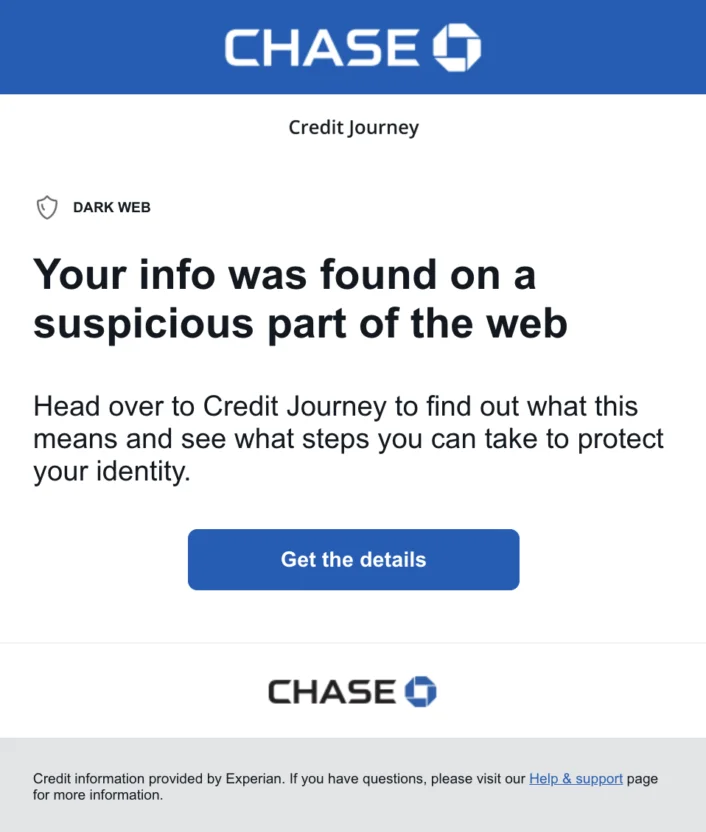
Example Subject Line To Use Here: “Important: Dark Web Alert”
Why It Works: Builds trust by showing proactive concern for customer security.
Quick, straightforward alerts like this make customers feel informed and confident about their bank’s commitment to customer protection. When customers see that their bank is actively monitoring their accounts and taking steps to safeguard their finances, they feel more secure while doing business with that institution. Including clear action steps, such as reviewing recent transactions or updating passwords, makes these emails even more effective.
10. Financial Education Newsletter Email
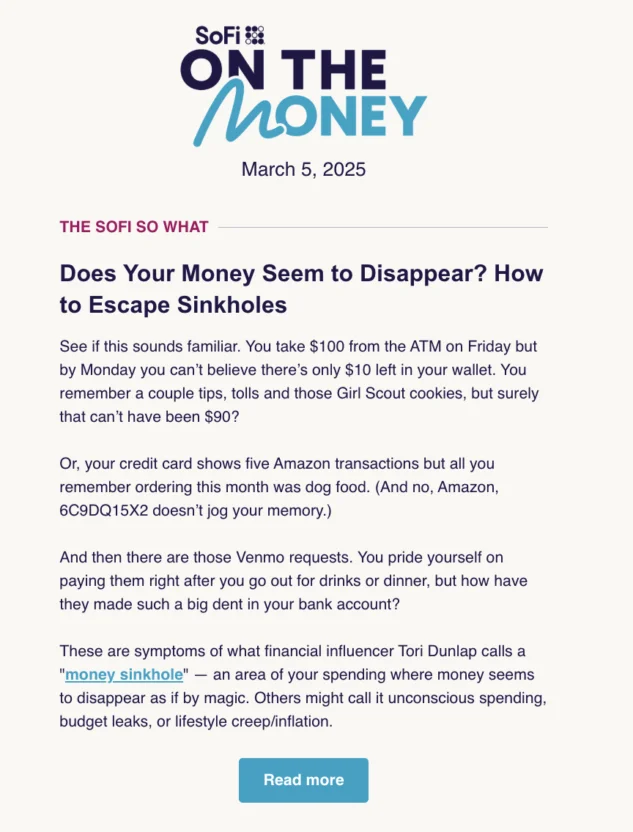
Example Subject Line To Use Here: “Escape Common Money Traps – Smart Financial Tips Inside!”
Why It Works: By providing valuable financial insights, banks and financial services companies position themselves as trusted advisors, rather than just service providers.
For most people, financial decisions are unfamiliar and daunting. Customers appreciate actionable tips that help them make smarter financial decisions, which fosters long-term loyalty.
In this example, financial institution SoFi is providing a branded “On the Money” newsletter, whose sole purpose is to share helpful information with its customers and help them solve a common pain point – the feeling that their money “disappears”.
This type of email is very effective for strengthening brand credibility. When customers see their financial institution taking the initiative to educate rather than just sell, they’re more likely to engage with future communications and trust them with additional services. The more empowered a customer feels about their finances, the more likely they are to stay loyal to a brand that supports their financial well-being.
Unlock Better Customer Engagement with MoEngage’s Relationship-Building Email Templates
Customer relationship engagement emails are a powerful tool for fostering customer loyalty and driving repeat business. With MoEngage’s AI-powered email marketing automation platform, you can automate and personalize your emails at scale, ensuring each customer gets the right message at the right time.
Get a demo of MoEngage’s email solutions to see how you can boost engagement today!








